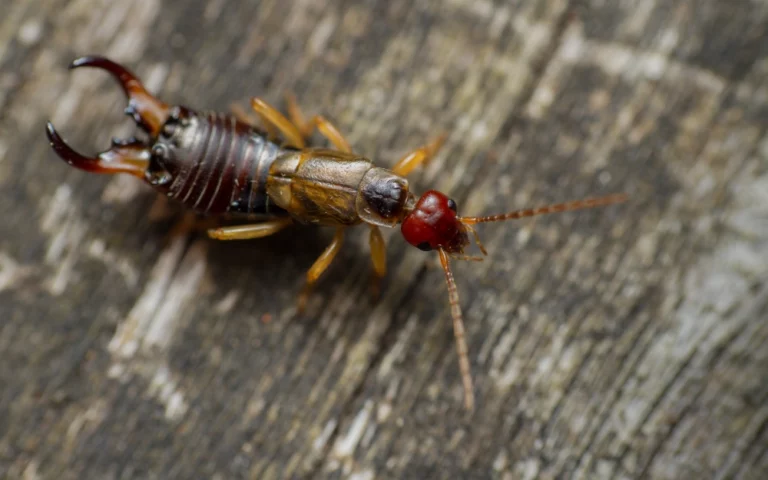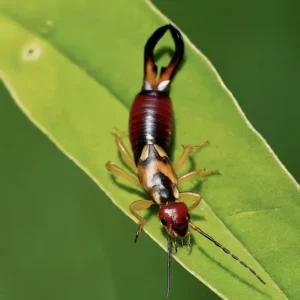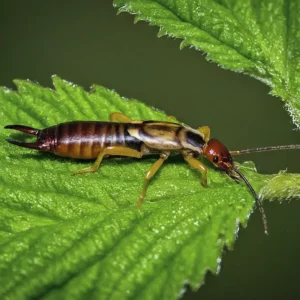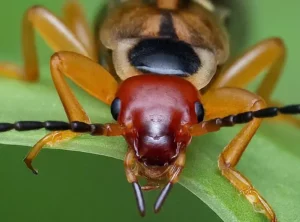Earwigs
Earwigs, often recognized by their distinctive pincers, are common household and garden pests that thrive in damp, dark environments. Understanding how to identify, prevent, and control earwig infestations is crucial for maintaining a pest-free home and garden. This page provides comprehensive information on earwigs, including their behavior, signs of infestation, and effective control methods. By following our expert tips, you can protect your home from these nocturnal insects. For professional assistance, don’t hesitate to contact On Demand Pest Control.

What Are Earwigs?
Earwigs, often recognized by their distinctive pincers, are common household and garden pests that thrive in damp, dark environments. Understanding how to identify, prevent, and control earwig infestations is crucial for maintaining a pest-free home and garden.
This page provides comprehensive information on earwigs, including their behavior, signs of infestation, and effective control methods. By following our expert tips, you can protect your home from these nocturnal insects. For professional assistance, don’t hesitate to contact On Demand Pest Control.
Identifying Earwigs
Earwigs are small, nocturnal insects known for their distinctive pincers and elongated bodies. Identifying earwigs is essential for recognizing and addressing infestations effectively. Here are key features to help identify them:
Appearance
- Size: Typically range from 5 to 25 millimeters in length.
- Color: Usually brown or black, sometimes with reddish hues or yellowish legs.
- Body: Slender and elongated with a smooth, shiny exoskeleton.
- Pincers: Forceps-like appendages (cerci) at the rear end; males have more curved pincers than females.

Behavior
- Activity: Nocturnal; hide during the day in dark, damp places.
- Habitat: Found under rocks, logs, mulch, and within leaf piles outdoors; indoors in basements, bathrooms, and kitchens.
Diet
- Food Sources: Feeds on plants, decaying organic matter, and small insects.
Key Identification Tips
- Look for the characteristic pincers at the rear end.
- Notice the elongated, smooth body structure.
- Observe their behavior; earwigs are active at night and hide during the day.
By accurately identifying earwigs, you can take the necessary steps to control and prevent infestations. If you suspect an infestation, contact On Demand Pest Control for professional assistance.
Signs of Earwig Infestation
Detecting an earwig infestation early can help prevent significant damage to your home and garden. Here are some common signs to look out for:
Visible Earwigs
- Nighttime Activity: Earwigs are nocturnal, so you’re more likely to see them active at night, especially in damp, dark areas.
- Daytime Hiding Spots: During the day, earwigs hide under rocks, logs, mulch, and leaf piles outdoors, or in basements, bathrooms, and kitchens indoors.
Damage to Plants
- Chewed Leaves and Flowers: Look for irregular holes and ragged edges on plant leaves, flowers, and soft fruits. Earwigs feed on a variety of plant materials and can cause noticeable damage.
- Presence in Gardens: They are often found in gardens with abundant food sources and moist environments.

Signs Indoors
- Moisture and Darkness: Indoors, earwigs are attracted to damp, dark places like basements, bathrooms, and laundry rooms. You might find them in these areas during the night or hidden during the day.
- Entry Points: They can enter through cracks in the foundation, gaps around doors and windows, or any other small openings.
Shed Exoskeletons
- Exoskeletons: Finding shed exoskeletons, especially around hiding places, is a sign that earwigs are present and growing.
How to Get Rid of Earwigs
Getting rid of earwigs involves a combination of preventive measures, natural remedies, and chemical treatments. Here’s a comprehensive guide to help you control earwig infestations effectively:
Preventive Measures
- Reduce Moisture: Earwigs are attracted to damp environments. Fix leaky pipes, use dehumidifiers in basements and bathrooms, and ensure proper drainage around your home.
- Seal Entry Points: Inspect your home for cracks and gaps, especially around doors, windows, and foundations, and seal them with caulk or weather stripping to prevent earwigs from entering.
- Remove Debris: Clear out piles of leaves, mulch, and wood that provide hiding places for earwigs. Keep your garden tidy and free of decaying plant material.
Natural Remedies
DIY Traps: Create simple traps using household items:
- Oil and Soy Sauce Trap: Fill a small container with a mixture of vegetable oil and soy sauce, and bury it near earwig activity. The smell attracts earwigs, and the oil prevents them from escaping.
- Dampened Newspaper: Roll up a damp newspaper and place it in the garden overnight. In the morning, shake the earwigs out into a bucket of soapy water to dispose of them.
Diatomaceous Earth: Sprinkle food-grade diatomaceous earth around plants and entry points. This natural powder dehydrates and kills earwigs upon contact, but it must be kept dry to be effective.
Natural Predators: Encourage birds, frogs, and other natural predators in your garden by providing birdhouses, bird baths, and suitable habitats.
Chemical Treatments
- Insecticides: Use insecticides containing ingredients like sevin, malathion, or pyrethrins. Follow the manufacturer’s instructions carefully and ensure the product is safe for indoor use if necessary.
- Bait Traps: Place commercial bait traps designed for earwigs in areas where they are commonly found. These traps often contain attractants and insecticides to lure and kill earwigs.
By combining these methods, you can effectively manage and reduce earwig populations in your home and garden. For persistent infestations, consider reaching out to On Demand Pest Control for professional assistance.
Preventing Earwig Infestations
Preventing an earwig infestation starts with making your home and garden less inviting to these pests. Here are some effective preventive measures:
Reduce Moisture
- Fix Leaks: Repair leaky pipes, faucets, and ensure proper drainage around your home to eliminate damp areas that attract earwigs.
- Dehumidifiers: Use dehumidifiers in basements, bathrooms, and other damp areas to reduce humidity levels.
- Gutters and Downspouts: Keep gutters clean and direct downspouts away from the foundation to prevent water buildup.

Seal Entry Points
- Cracks and Gaps: Inspect your home for cracks and gaps around doors, windows, and the foundation, and seal them with caulk or weather stripping.
- Screens and Doors: Ensure window screens are intact and doors fit tightly to prevent earwigs from entering your home.
Remove Debris
- Garden Maintenance: Regularly clear out garden debris such as leaves, mulch, and wood piles where earwigs can hide. Keep the area around your home’s foundation free of organic material.
- Firewood Storage: Store firewood away from the house and off the ground to reduce hiding places for earwigs.
Use Natural Deterrents
- Strong-Smelling Plants: Plant herbs like rosemary, lavender, garlic, and peppermint around your garden, as earwigs tend to avoid these strong scents.
- Natural Predators: Encourage birds, frogs, and other natural predators by providing birdhouses, bird baths, and a diverse garden environment.
By implementing these preventive measures, you can create a less hospitable environment for earwigs and reduce the likelihood of an infestation. If you continue to have issues with earwigs, consider contacting On Demand Pest Control for professional help.
Frequently Asked Questions
No, earwigs do not bite humans. While they have pincers, they use them primarily for defense and capturing prey. If threatened, an earwig might pinch, but this is generally harmless to humans and rarely breaks the skin.
To get rid of earwigs in your house:
- Reduce Moisture: Fix any leaks and use dehumidifiers in damp areas like basements and bathrooms.
- Seal Entry Points: Close gaps around doors, windows, and foundations with caulk or weather stripping.
- Remove Hiding Places: Clear out clutter and debris where earwigs can hide, both inside and outside your home.
- Use Traps and Insecticides: Set up DIY traps using oil and soy sauce, and consider using insecticides labeled for indoor use.
The name “earwig” comes from an old superstition that these insects would crawl into people’s ears and burrow into their brains. This myth is not true; earwigs do not seek out human ears.
No, earwigs do not intentionally crawl into human ears. This is a myth. While any small insect can accidentally enter an ear, earwigs do not have a particular attraction to human ears.
Yes, earwigs can be harmful to plants. They feed on leaves, flowers, and soft fruits, causing noticeable damage. However, they can also help by eating other pests like aphids, so their presence isn’t always entirely negative.
Earwigs are omnivores and will eat a variety of things, including plant material, decaying organic matter, and small insects. They are particularly fond of moist, decomposing vegetation and plant debris.
Preventing earwig infestations involves making your home and garden less hospitable to them:
- Reduce Moisture: Fix leaks and use dehumidifiers.
- Seal Entry Points: Close gaps and cracks around your home.
- Remove Debris: Clear out garden and home clutter where earwigs might hide.
- Use Natural Deterrents: Plant strong-smelling herbs like rosemary and lavender, and encourage natural predators like birds and frogs.
Get Professional Help for Earwig Infestations
Earwigs can be a nuisance both indoors and in the garden, but with proper identification, prevention, and control measures, you can manage and reduce their presence effectively. By understanding their behavior, taking steps to make your environment less inviting, and using a combination of natural and chemical treatments, you can keep earwigs at bay.
If you’re dealing with a persistent earwig problem or need professional assistance, don’t hesitate to reach out to On Demand Pest Control. Our expert team is here to help you protect your home and garden from earwig infestations.
Nearby Locations We Serve
For more information or to schedule a service, contact On Demand Pest Control today and ensure a pest-free environment for your home and garden.
For further inquiries or immediate assistance, visit our contact page or call us at (954) 947-0805. Our team is ready to provide you with the best pest control solutions tailored to your needs.
